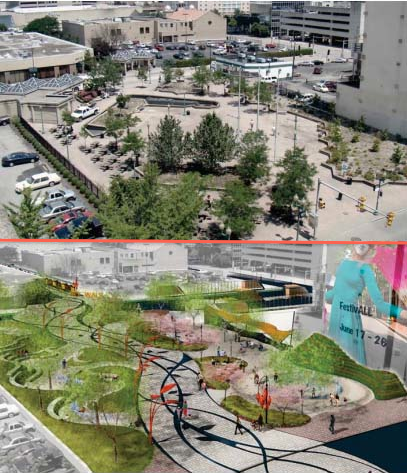Let’s say you worked for a city that was trying to revitalize a piece of land with a bunch of dilapidated buildings on it. You want to build some residences and some retail space, and you want to make better connections to the street grid. Congratulations – HUD and U.S. DOT both have money to help you get where you’re going. Except, oops: HUD is going to demand that you hire locally, to create jobs in the community, while U.S. DOT is going to demand that you get a competitive bid, showing no preference for local hires. Everyone you talk to at either agency just scratches their heads and says they don’t know anything about the other agency. They wouldn’t even know who to talk to over there.

Well, you can relax, because that type of bureaucratic snafu is a thing of the past. But that was the state of affairs until about three years ago, when DOT, HUD, and the EPA got together to eliminate some of the bureaucratic hurdles that had long frustrated the communities they were trying to serve. They called it the Partnership for Sustainable Communities, and it broke down the silos of the three agencies with their naturally interconnected missions. They outlined six principles of livability to support investment in existing communities, transportation choices, affordable housing, and good stuff like that.
House Republicans sprang into action. They succeeded in de-funding the program, even trying to insert legislative language that prohibits the three agencies from working together on sustainable development. (See page 78 of this PDF.)
But this partnership is broader and deeper than its antagonists think.
With or without a name or funding, government agencies are beginning to work together around a common mission of smart growth and livability. And not just the big three: The EPA has signed a formal memorandum of agreement with the National Oceanic and Atmospheric Administration (NOAA) on sustainable land use in coastal areas, tackling questions like how to improve walkability when everything is built on stilts.
And other agencies are getting in on the action. The U.S. Department of Agriculture’s Rural Development office “wishes they’d been at the wedding,” according to Abby Hall, policy analyst with the EPA’s Smart Growth program. The USDA has worked with the Partnership on livability guidance for rural America. It runs its own infrastructure bank, which incorporates sustainability principles.
For example, while many small towns try to revitalize by chasing after big companies to build plants there, the Rural Development office encourages communities to build places where people want to live and conduct commerce. They just cut the ribbon on a new City Hall in southeastern Arkansas, consolidating four local agencies in a renovated historic building on what had been a somewhat moribund Main Street. The town’s mayor told officials that with the opening of the building, businesses and developers are suddenly interested in putting down roots there.
The USDA’s involvement helps the other agencies make inroads in rural areas, where improving livability plays out differently than in an urban setting.
The Partnership's repercussions are felt even farther afield. The Federal Emergency Management Agency (FEMA) has also formalized its close working relationship with the Partnership for Sustainable Communities. In concert with the other agencies, FEMA is trying to rebuild smarter after disasters, making damaged streets complete streets when they rehab them.
Community planning does and should happen at the local level, so FEMA and the Partnership provide resources to help communities align their comprehensive long-term plans with their disaster recovery plans. When Vermont rebuilt after Hurricane Irene, the first “livability” concern was just getting people home when roads and bridges were destroyed, as one VDOT official told Streetsblog. But what if every recovery plan incorporated the public’s wishes for sustainable design and complete streets? Without causing delays or costing more money, each community could rebuild smarter than before. FEMA recognizes that and is collaborating with other agencies to make it happen.
It's hard to imagine why this work is so threatening to so many people, but it's been under attack from Congressional Republicans since the word "go." Congress has zeroed out the HUD’s Office of Sustainable Communities, killing off the Regional Planning and Community Challenge grant programs, which helped communities plan their land use, housing and transportation in a cohesive way.
The House Appropriations bill for 2013 also de-funds the EPA Smart Growth Office, which started bringing a sustainability focus to that agency’s work more than a decade before the Partnership began. That would be a blow, ending wildly popular technical assistance programs, several of which involve other agencies. These programs have helped create a multi-modal transportation hub and well-used town square in an area of Charleston, West Virginia that didn’t have any green space; they worked to reverse suburban sprawl in Little Rock, Arkansas; they helped catalyze infill development and walkability in Teton County, Idaho – the list goes on and on. The elimination of those programs would be an enormous loss for communities all around the country.
But grantmaking is just one part of the overall collaboration. The Partnership has seen the smart growth ethic permeate much of the work of the agencies involved. For instance, funds for clean water are the largest funding pot that the EPA allocates to state governments. As part of the Partnership, the EPA started to issue guidance that’s consistent with livability principles. The agency now recommends that states follow a fix-it-first approach to water infrastructure, maintaining existing infrastructure before embarking on new development in greenfields. Building water infrastructure in undeveloped areas is a primary driver of suburban sprawl, making it cheaper and easier to build there.
“With or without clear funding streams, one thing we’re trying to do is make sure that EPA, HUD, and DOT staff at the regional level know each other personally, that they have meetings, that they talk on the phone, and that they’re coordinating their day to day work,” said EPA's Hall. “It’s not just a top-down partnership. The strength of it has been putting regional staff in touch with each other.”





